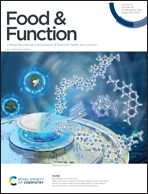Identification and analysis of antioxidant peptides from sorghum (Sorghum bicolor L. Moench) on the basis of in vitro simulated gastrointestinal digestion
Abstract
Sorghum (Sorghum bicolor L. Moench) antioxidant peptides in vitro simulated through continuous gastrointestinal (GI) digestion in comparison with rice (Oryza sativa L.) were identified and functionally analysed. It was demonstrated that the protein digestibility of sorghum and rice increased by 11.27% and 14.10% after GI digestion, respectively. The concentrations of the rice peptides GG14, GG12, SF11, and LQ9 and the sorghum peptide KP9 in the gastrointestinal tract were 0.018, 0.712, 0.548, 0.188, and 0.265 μg mL−1, respectively. An assay of the scavenging ability showed that the sorghum peptide KP9 had the strongest ABTS-scavenging ability, with an IC50 value of 44.44 mg mL−1. The rice peptide LQ9 had the strongest DPPH and OH radical scavenging activity, with IC50 values of 10.41 and 25.78 mg mL−1, respectively. These five selectively synthesized peptides were predicted to be nontoxic and to have good ADMET absorption properties. The results indicated that the sorghum and rice peptides obtained by in vitro digestion were separated and purified with certain antioxidant activities and could be consumed as functional foods to modulate certain chronic diseases.



 Please wait while we load your content...
Please wait while we load your content...